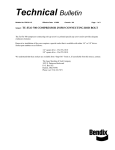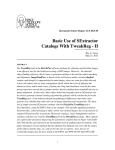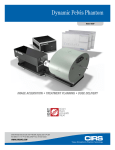Download User guide, technical part,May06 Indiana University Cyclotron Facility
Transcript
User guide, technical part,May06 This guide is provided to help users plan for their radiation effects tests at IUCF. General features of the radiation test station are described. Users are encouraged to communicate open questions and special requirements to B. von Przewoski ([email protected] (812) 855 2913) Indiana University Cyclotron Facility Figure 1 shows the layout of IUCF including projects under construction. RERP (dark blue) consists of two new irradiation rooms, RERS1 and RERS2. The neutron facility consisting of LENS (Low Energy Neutron Scattering) and NREP (Neutron Radiation Effects Program) is indicated in light blue. First neutron beams for radiation testing have been available since October 2005. Figure 1: IUCF with RERP, dark blue, and NREP syn. RERPIII, light blue. The beam The IUCF cyclotrons accelerate protons to 205 MeV. Degraded beam energies as low as about 50 MeV are available. The usual beam spot size is up to 7cm in diameter with uniformity <40%. The irradiated area may be restricted by use of collimators. There is an inventory of collimators available in Appendix VI of this user’s guide. Larger beam spot sizes (up to 30 cm diameter) are also available. The beam spot size should be chosen to roughly match the size of the device under test (DUT). Beam spots larger than necessary result in activation of materials close to the DUT (cables, connectors etc.). If the beam spot diameter is increased while the flux is kept constant, the total number of protons per second admitted to the cave must be increased. This causes the ambient neutron background to be higher than for the smaller beam spot. Testers may require extra shielding when a large beam spot is used. Available beam fluxes at 200 MeV are between 102 and 1011 p/s/cm2. For maximum fluxes at degraded energies see section about degraded energies. The maximum flux corresponds to a beam spot size of about 3 cm2 and a beam current of about 300 nA out of the cyclotron. During daytime hours (8:00am – 5:00pm) beam currents out of the cyclotron are limited to 50nA. A convenient flux calculator for both beamlines can be found on our website at http://www.iucf.indiana.edu/rerp/maxflux.php. Dosimetry IUCF provides the dosimetry. For fluxes between 106-1011 p/s/cm2 the dosimetry is done with a calibrated secondary electron monitor. At lower fluxes (as low as 102 p/s/cm2) we use a small scintillator for dosimetry. We need to know at which flux you are looking to irradiate in order to set up the dosimetry in advance. The lateral dose distribution of the beam is measured using Gafchromic film type HD-810. Figure 2 shows an example of the dose as a function of position across the beam. Dose (kRad(Si)) 30 25 20 15 10 5 0 -45 -40-35 -30 -25-20 -15 -10 -5 0 5 10 15 20 25 30 35 40 45 Position (mm) Top to Bottom Left to Right Figure 2: The left panel shows Gafchromic film type HD-810 irradiated to 30kRad (Si). The right side shows the vertical and horizontal dose distribution. The irradiation stations The DUT is in air, which makes it easily accessible. No vacuum feedthroughs are required. Dimensions of both irradiation areas and mazes can be found in Appendix I. As for mounting the devices in the beam: each room has an x,y,z adjustable table, which is remotely positionable from the DAQ in the two dimensions, x and y, perpendicular to the beam direction, and several vise grips to hold boards, systems and the like. The table will support DUTs as large as 3′ x 3′ and as heavy as 200 lbs. The range of motion of the table is 18" horizontally (x) and 12" vertically. Alignment of the DUT is conveniently accomplished with a laser which points in the beam direction. There is additional table space near the end of the beamline, e.g. to set up power supplies. Figure 3 shows a diagram of RERS1(2). A collimator to restrict the beam size may be mounted to the end of the beamline (#5). Both beamlines allow to degrade the beam energy by means of a Cu degrader between #5 and #6 immediately upstream of the DUT. RERS2 also offers beryllium degraders upstream of a momentum analysis magnet (see below). Fig.3: Beam goes from left to right. Number 1 is the removable stop which turns the beam on and off. #2 is a target ladder with a scintillator for beam alignment and a Cu foil to spread the beam. #3 is the defining collimator and secondary emission monitor (SEM). #4 is a removable Faraday cup and #6 is the entrance to the beam dump. Devices under test (DUTs) are placed in air between 5 and 6. The distance between the DUT and the data acquisition area is about 80 ft. Some standard cables along this length are provided and listed in Appendix VII. If you need special cables to connect to your equipment inside the radiation area, you need to bring them. Equipment other than the DUT can be in the irradiation area. Sometimes equipment requires shielding from neutron background, which can for instance upset a tester. Cables between the DUT and equipment that requires shielding from neutrons should be long enough to allow placement of that equipment behind a concrete wall of the shielding maze leading to the irradiation area (see area layout Appendix I). DEGRADED BEAM ENERGIES If the beam energy is degraded, the maximum available flux is reduced. Any energy degrader will spread the beam laterally and thus decrease the number of protons/s/cm2. In RERS1 the flux reduction due to the presence of the degrader is negligible while in RERS2 the maximum available flux is about two orders of magnitude lower at 50 MeV than at 200 MeV (See Appendix V). If the beam spot size is large, the flux will be further reduced. The maximum flux calculator at http://www.iucf.indiana.edu/rerp/maxflux.php may be used to predict the flux in either beamline, for a particular energy and spot size. RERS1 AND RERS2 Lower energies may be obtained by placing a Cu degrader immediately upstream of the DUT. In RERS1 degraders are mounted on a remotely operated degrader positioner which has room for up to four degraders. If this positioner is used it only takes a minute or less to change the energy. If more than 4 energies are required, the three degraders may be changed in about 10 minutes. Straggling increases the energy spread of degraded beams. Without momentum selection between the degrader and the DUT the beam energy spread increases with degrader thickness (see Appendix II). RERS2 In RERS2 beam energies below 200 MeV may be obtained by degrading the beam far upstream of the DUT. The energy is momentum analyzed by a dipole and slit system downstream of a beryllium degrader. This results in a narrow beam energy spread also for lower beam energies. Neither the degrader nor the dipole and slit system are located in the irradiation room. Appendix III illustrates the difference in beam energy spread for the lowest available energy (~50 MeV) in both beamlines. The data in Appendix III were obtained using a multi-leaf Faraday Cup (MLFC). The MLFC consists of 30 layers of 0.5 mm thick Al leaves alternating with 80μm thick kapton sheets. The protons stop in the Al layers and the current from each Al sheet is read out. The highest current is measured where the beam ranges out. The larger width of the curve labeled RERS1 (Appendix III) is due to the presence of the degrader upstream of the DUT. The width of the curve labeled RERS2 does not represent the beam energy spread, which is much smaller. Instead, the width is due to straggling in the front plate and the Al of the MLFC itself. The energy of the beam at the DUT (device under test) can be determined from energy loss calculations in two ways. 1.) The starting energy for an energy loss calculation is optimized such that the beam stops in the Al layer as determined from the MLFC spectrum . 2.) The energy as determined by the trunkline MLFC is used and the energy loss in the Be degrader is taken into account to calculate the energy at the DUT. The two calculations give the same result within error. Table 1, Appendix IV lists the energies obtained both ways. The error estimate is based on the uncertainty introduced by different iteration methods in the energy loss calculations. The flux depends strongly on energy, because the momentum selection system only transmits that portion of the beam which has the desired energy downstream of the beryllium degrader. Obviously, there is a trade-off of narrow beam energy spread vs intensity. Appendix V lists maximum flux as a function of energy. The method of choice to degrade the beam energy depends on the application and whether high flux or small energy spread is the prime concern. TAGGED PROTONS (RERS1) Tagged protons are obtained by scattering the beam protons off the hydrogen contained in a CH2 (polyethylene) target. Elastic proton-proton scattering events are easily identified by the characteristic opening angle (~90º) between the protons. If a scattered proton is detected at ~90º relative to the DUT, the accompanying recoil at the location of the DUT is called a tagged proton. Since tagged protons are obtained via a nuclear reaction, their flux is very low. Tagged protons require a dedicated setup. Please contact B. von Przewoski ([email protected] (812) 855 2913) for details. Our website: http://www.iucf.indiana.edu/rerp Appendix I: area dimensions maze maze Area dimensions of RERS1 and RERS2 as of 2/19/04. The mazes are also shown. All dimensions are in inch. The beam height above floor is 76″ and the ceiling height in the mazes is 8 ft Appendix II: degraded beam energy spread Beam energy spread as a function of degraded beam energy. The points are results from SRIM calculations for Cu degraders of 0.50, 1.90, 3.18 and 3.98 cm. The line is an exponential fit to guide the eye. Appendix III: Beam energy spread Multi Leaf Faraday Cup spectra (see section about degraded beams) for degraded beams in RERS1 and RERS2. The difference in width between the two curves is due to the presence of the degrader immediately upstream of the DUT in RERS1. The lines are SRIM calculations Appendix IV: Beam energies (RERS2) T at DUT from RERS2 MLFC (red) 204.8 +/-1.3 199.6 +/-1.3 205.7 +/-1.3 205.8 +/-1.3 149.6 +/-0.4 141.7 +/-0.4 148.4 +/-0.4 99.4 +/-0.2 99.4 +/-0.2 90.8 +/-0.2 101.3 +/-0.2 69.6 +/-0.1 66.8 +/-0.1 66.9 +/-0.1 69.4 +/-0.1 54.6 +/-0.1 51.0 +/-0.1 48.4 +/-0.1 T at DUT from energy loss in Be (blue) 204.8 +/-1.3 199.9 +/-1.3 206.2 +/-1.3 206.2 +/-1.3 150.2 +/-1.3 142.4 +/-1.3 148.5 +/-1.3 100.4 +/-1.4 100.4 +/-1.4 92.2 +/-1.4 102.4 +/-1.4 71.8 +/-1.5 68.8 +/-1.5 68.8 +/-1.5 71.8 +/-1.5 57.7 +/-1.5 51.5 +/-1.6 47.7 +/-1.6 Energies without degrader and with the four Be degraders. The slightly different energies per degrader correspond to different spreaders. The x-axis is arbitrary for ease of plotting. The red points correspond to the energy at the DUT as calculated from the MLFC at the end of the RERS2 beamline. The blue points are energy loss calculations using the trunkline MLFC as the starting energy. Appendix V: available flux Table 1: Fluxes for a 2.5 cm diameter beamspot as a function of energy for both beamlines and for a daytime beam current of 50 nA out of the cyclotron Energy (MeV) 200 149 102 72 52 Flux (p/s/cm2) RERS1 1.5e10 1.4e10 1.3e10 1.1e10 1.1e10 Flux (p/s/cm2) RERS2 1.5e10 3.0e9 7.4e8 3.0e8 1.6e8 Appendix VI: available collimator sizes 1.18" dia. (round) 1"x1.5", 1"x2.5", 2"x2.25" (rectangular) 1"x1", 1.25"x1.25", 1.875"x1.875 " (square) Appendix VII: cables between irradiation area and DAQ (80′) BNC, RS232, AC power controlled from DAQ, GPIB, keyboard cable, monitor cable, 8 BNC cables, 8 SHV cables Note: not all PCs drive a 80′ keyboard or monitor cable Appendix VIII: unit conversion The relationship between dose (Si), dose (Gy) and fluence (cm-2) for 1cm of silicon is shown in the graph above. For instance at 200 MeV a fluence of 1010 cm-2 equals 0.6 krad Si or 0.006 Gy. The lines correspond to 50, 100, 150 and 200 MeV.





















